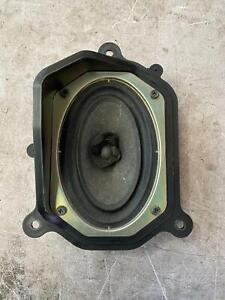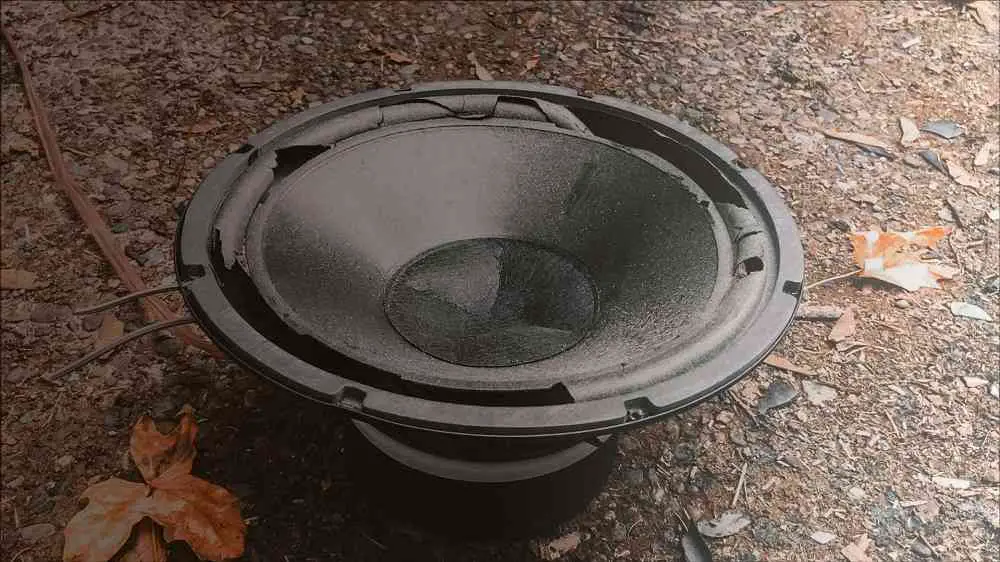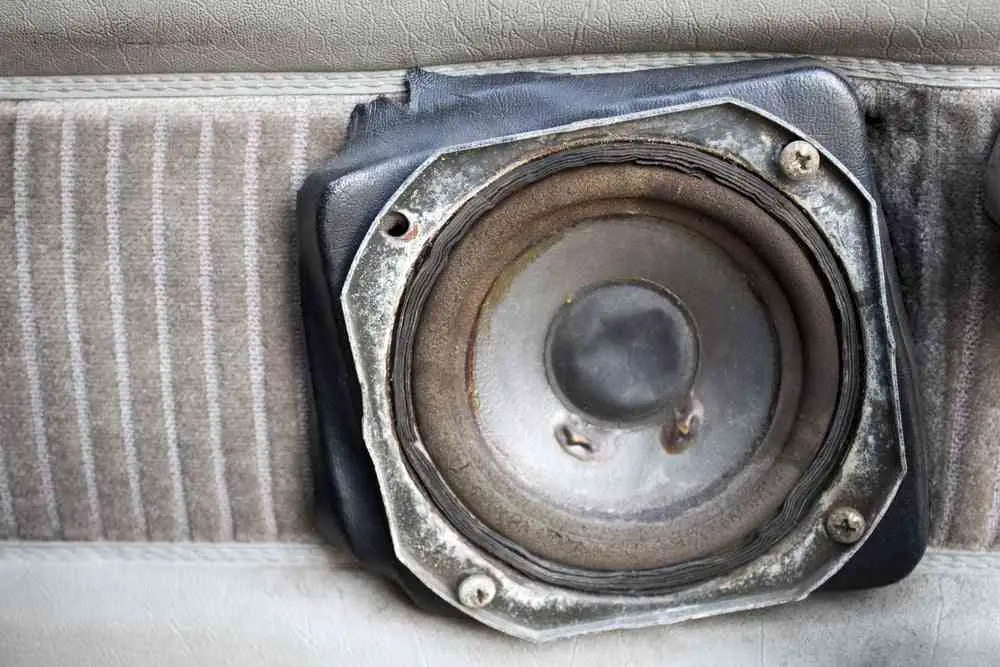One of the most common issues faced by car owners is a blown car speaker.
A blown speaker can produce a distorted or muffled sound, no sound at all, crackling or popping noise, or rattling or buzzing noise.

This can greatly impact the overall listening experience in the car, making it difficult to enjoy music or even hear navigation instructions.
In this article, we will discuss the causes of a blown car speaker, the tools and materials needed to fix it, and step-by-step instructions to fix the issue.
Symptoms of a Blown Car Speaker
There are many symptoms of blown speakers, which are-
Distorted or muffled sound:
This is the most common symptom of a blown speaker. The sound may be difficult to understand, and the music may not sound as clear as it should. The distortion can be heard as crackling, popping, or fuzzy noise.
No sound at all from the speaker:
If one of your car speakers isn’t producing any sound, it is likely that it has blown.
The speaker might be completely silent or produce a faint sound.
Crackling or popping noise:
This can be caused by a malfunctioning speaker or damaged wiring.

It can be heard when the volume is turned up or down, or when switching between tracks.
Rattling or buzzing noise:
These noises can be caused by a loose or damaged speaker.
The speaker might produce a rattling or buzzing noise when the volume is turned up or when playing certain tracks.
Distorted Bass:
The bass might be distorted, it might sound fuzzy, or the bass might not be present at all.
Reduced Volume:
The volume of the speaker might be significantly reduced, making it hard to hear the audio coming from it.
Sound only coming from one speaker:
If the sound is only coming from one speaker, the other speaker might be blown.
It is important to note that a blown car speaker may not show all the symptoms, it might show only one or two of them. It is recommended to have a professional check the speaker if you have any doubts.
Causes of a Blown Car Speaker
Here are some of the reasons why your speaker may be blown-
Overheating due to high volume or prolonged use:
The speaker’s voice coil can overheat if it’s played at high volume for a prolonged period.
This can cause the speaker to blow. The voice coil can also overheat if the speaker is working under high power for an extended period of time.
Exposure to moisture or extreme temperatures:
Exposure to moisture or extreme temperatures can cause damage to the speaker or its wiring, resulting in a blown speaker.
Moisture can cause corrosion on the speaker terminals, while extreme temperatures can cause the materials of the speaker to expand and contract, causing damage.
Blown fuse or damaged wiring:
A blown fuse or damaged wiring can prevent the speaker from functioning properly.
A blown fuse can be caused by a power surge, while damaged wiring can be caused by wear and tear, or an accident.
Overdriving the speaker with too much power:
When an amplifier is sending too much power to the speaker, it can cause the speaker to blow.
The speaker might not be able to handle the power it is receiving, causing the voice coil to overheat and burn out.
Age:
With time, the speaker cones can become brittle, or the suspension might lose its elasticity, causing the speaker to blow.
Incorrect installation:
If the speaker is not installed correctly, it can cause it to blow. This can happen if the speaker is not wired correctly, or if the speaker is not supported properly.
It is important to note that the most common cause of a blown car speaker is overheating due to high volume or prolonged use.
However, a combination of factors can lead to a blown speaker. It is recommended to have a professional check the speaker if you have any doubts.
Tools and Materials Needed
- Screwdriver: A screwdriver is necessary to remove the speaker cover.
- Multimeter: A multimeter is used to test the speaker and wiring to identify any issues.
- Replacement speaker: If necessary, a replacement speaker will be needed.
- Soldering iron and wire: If there are any issues with the wiring, a soldering iron and wire will be needed to rewire the speaker.

Steps to Fix a Blown Car Speaker
Step 1: Remove the speaker cover and examine the speaker.
Locate the speaker in your car and remove the cover using a screwdriver.
Examine the speaker for any visible damage, such as a torn cone or a burnt smell.
If you find any issues in the cone, you might need to replace the speaker following the step 4.
Step 2: Test the speaker and wiring using a multimeter.
Set the multimeter to “Ohms” and touch the probes to the speaker terminals.
A reading of infinity or a very high number indicates an open circuit, which means the speaker is blown.
A reading of zero or a very low number indicates a short circuit, which could be caused by damaged wiring.
In many cases, the wires will have been damaged or the connection would be corroded.
Step 3: Identify and fix any issues with the wiring.
If there is a short circuit, check for any visible damage to the wiring, such as frayed or broken wires.
If necessary, use a soldering iron to repair or replace damaged wiring.
If needed, reconnect the speaker wires to the terminals.
Step 4: Replace the speaker if necessary.
If the speaker is visibly damaged or if the multimeter indicates an open circuit, the speaker will need to be replaced.
Make sure to purchase a replacement speaker that is compatible with your car’s audio system.
Specific installation guide will be provided with the speaker’s user manual and your car’s owner’s manual. Follow those to properly install your new speaker.
Step 5: Reinstall the speaker cover and test the sound.
Carefully reinstall the speaker cover, making sure that all screws are tight.
Test the sound by turning on the car’s audio system and listening to the speaker.

Conclusion
Fixing a blown car speaker can seem daunting, but with the right tools and information, it’s a task that can be easily accomplished.
By following these steps, you will be able to identify and fix the issue, whether it’s caused by a blown speaker, damaged wiring, or a blown fuse.
Remember to always use your car’s audio system responsibly, and to maintain it regularly to avoid future issues.
Additionally, it is important to note that if you are not comfortable with working on your car’s audio system, it is always best to seek the help of a professional.
They will have the knowledge and expertise to diagnose and fix the problem safely and efficiently.
By following the guidelines provided in this article, you will be able to fix your blown car speaker and enjoy the best listening experience possible.
How can I prevent my car speakers from blowing in the future?
To prevent your car speakers from blowing in the future, it’s important to use your car’s audio system responsibly.
Avoid playing music at high volumes for prolonged periods of time and make sure to protect your car from moisture and extreme temperatures.
Additionally, make sure that your car’s audio system is in good working condition and that the wiring is not damaged.
Can I fix a blown car speaker myself or do I need a professional?
You can fix a blown car speaker yourself if you have the right tools and knowledge.
However, if you are not comfortable working on your car’s audio system, it’s best to seek the help of a professional.
They will have the knowledge and expertise to diagnose and fix the problem safely and efficiently.
What should I do if my car speaker is making a rattling or buzzing noise?
A rattling or buzzing noise can be caused by a loose or damaged speaker.
First, try tightening any screws that hold the speaker in place. If that doesn’t fix the problem, the speaker may need to be replaced.
Can I just replace the blown speaker or do I need to replace the entire audio system?
In most cases, you can just replace the blown speaker.
However, if the issue is caused by a problem with the audio system, such as a blown fuse or damaged wiring, then you may need to replace the entire audio system.
Will the warranty on my car cover the replacement of a blown speaker?
It depends on the warranty on your car. Some warranties may cover the replacement of a blown speaker, while others may not.
It’s best to check your warranty and contact the manufacturer or dealership for more information.
